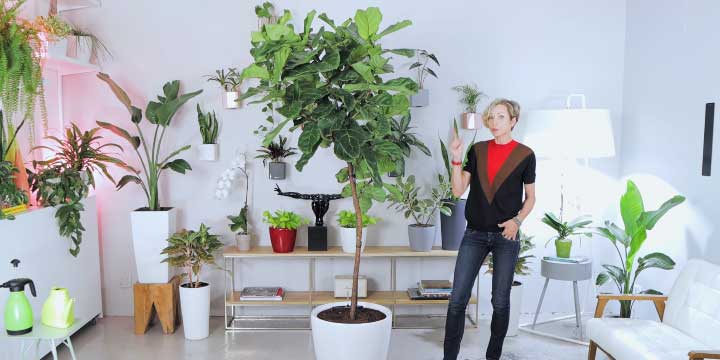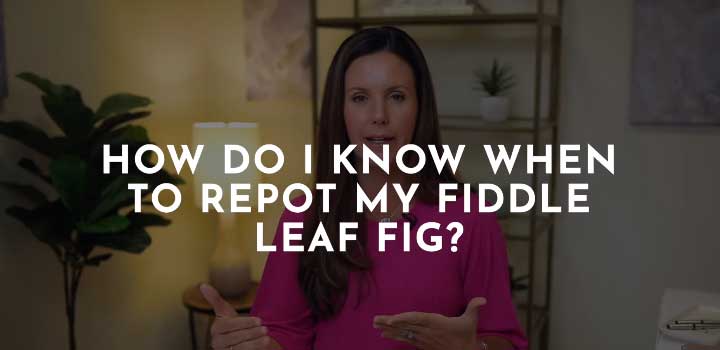Fiddle-leaf fig plants are very flexible in terms of container size. They will grow up to the maximum capacity a container allows. If you want your small fiddle leaf fig plant to grow larger than it currently is, all you need to do is repot it into a larger container.
However, this process is trickier than it may seem. Even if you have some experience repotting other plants, you will need to put some extra effort into repotting a fiddle leaf fig, as they are infamous for their highly delicate nature and root ball.
Here, you’ll learn how to report fiddle leaf fig without damaging the plant. So, let’s get started.
3 Signs Your Fiddle Leaf Fig Needs Repotting
Usually, fiddle leaf figs grow more than 2 feet annually. Whenever you notice your plant isn’t growing enough, you should immediately check the signs for repotting it before it dies. Here are the common signs your fiddle leaf requires repotting.
- If root rot occurs in your fiddle leaf fig, it’s one of the significant reasons your plant stopped growing and needs a new pot.
- Another reason for repotting is poor soil quality. If you haven’t changed the soil mix for a long time, you should repot your fiddle leaf fig.
- When you can see the brown spots on fig leaves, it’s a visible sign your plant needs repotting.
Things to Consider for Repotting Fiddle Leaf Fig
Before getting started with the repotting process, you’ll want to prepare the container and potting soil as necessary. Doing so will help smoothen out the repotting process, and it will also keep the plant from damage.

Selecting the Right Container
It’s important to choose a container that’ll provide enough space for the plant to grow and won’t be too overwhelming for you either.
As I’ve said earlier, the plant will grow with all the capacity the container provides. So, picking too large a container might end up being troublesome to you.
Ensuring Proper Drainage
Ensuring drainage is one of the most important steps of repotting, and beginners often overlook it. If the drainage system is absent from the container, it will overflow whenever you water the plant.
Plus, Fiddle leaf fig plants are susceptible to rot, so you should avoid that. On the other hand, you’ll need to water an overly porous container more often than usual. I think the container that comes with the perfect drainage system is a great choice.
A lot of people believe that putting gravel on the bottom of the container can reduce water saturation. The reality is that the gravels increase the soil’s water saturation, which can be harmful to the plant. So, I didn’t like it!
Choosing a Potting Soil
Getting the top soil for Fiddle leaf fig is crucial as it’s a very delicate plant. While using the soil from your backyard or lawn can be tempting, it’s not recommended at all.
Plants like this require a lot of aeration and water retention, which is why you should pick potting soil that’s created specifically for this plant or plants of this type.
I suggest getting a moisture meter. This effective tool will inform you when your plants require water, and you’ll be able to water appropriately without overwatering or leaving the container dry.
Repotting a Fiddle Leaf Fig Tree
This section will discuss the repotting process that you should follow for repotting a fiddle leaf fig tree. So, let’s get started.
Step One: Mixing the Soil
The first thing that you should do is mixing up the soil. There are different types of soils to choose from, and as long as you choose a soil that suits the plant, you can’t go wrong.
Step Two: Getting the Plant Out
A lot of people find this step rather challenging. You can’t remove a fiddle leaf fig tree holding the stem.
The best way of getting the plant out of the pot is to remove the soil till the root is completely revealed. Once there, you can remove it holding the root or the base.

However, if that seems tiring for you, you can follow the other method. Tip the pot sideways and try wiggling the plant out by holding the base. Be cautious and take your time with this; otherwise, you may end up damaging the root.
Once the plant is uprooted, you need to break away any old soil stuck to the roots.
Step Three: Filling One-Third of the Container with Soil
Now you need to fill one-third of the new container with the new soil that you will be using. Once done, place the plant in the soil to see how much it will remain covered when it’s covered with soil.
Typically, you’ll want to cover all the roots of the plant with soil, and you shouldn’t cover more than 1 inch of the base from the bottom. So, you can add or remove soil to bring the plant to an appropriate level.
Step Four: Placing the Root Ball
Once you manage to find the appropriate level for your plant, it’s time to start filling. Placing the root ball is an important step, as you need to keep the plant standing upright when you are doing so.
We highly recommend seeking help from someone else, as two pairs of hands can make things much simpler.
While keeping the plant upright, pour soil slowly. Don’t pour them all at once; rather, pour small amounts and pat the soil so that air pockets are not created.
The aeration provided by potting soil will be enough to meet the requirements of the plant.
During this step, make sure you pat the soil around the roots. This will connect the roots with the soil more effectively, allowing them to receive the nutrients and water from the soil effortlessly.
Step Five: Water the Plant
Watering the plant right after planting will move the soil and settle it around the roots. That will eliminate any gap between the root and the soil.
Plus, it’ll also keep the plant from getting thirsty. It’s completely normal if the soil level lowers from watering.
Precaution: Don’t Fertilize Just Yet!
Fertilizing the plant right after repotting isn’t recommended. We recommend giving the plant at least a month for adjusting to the transition. You can start fertilizing after that period.
Conclusion
Following these steps for preparing and repotting can help you plant and take care of Fiddle Leaf Fig plant effectively. We highly recommend sticking to the rules as this plant is very delicate.
Nevertheless, let us know if you liked our guide on how to repot fiddle leaf fig.